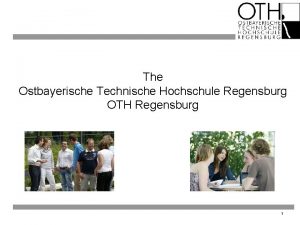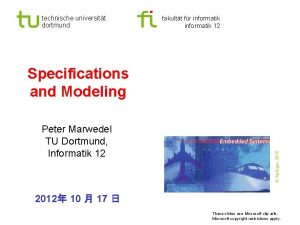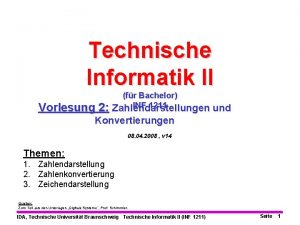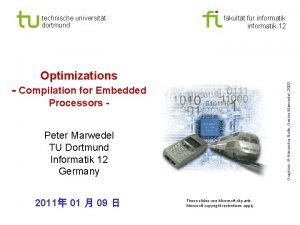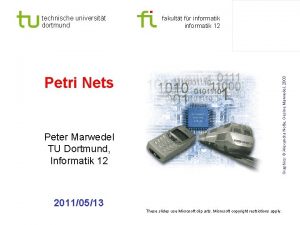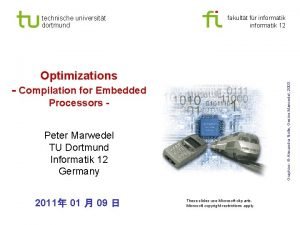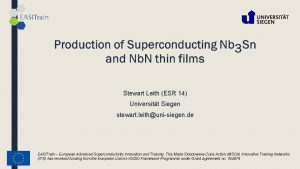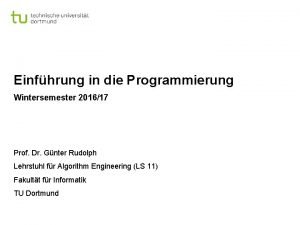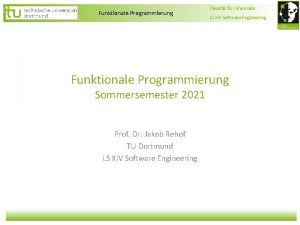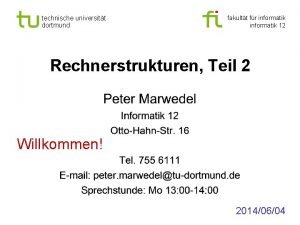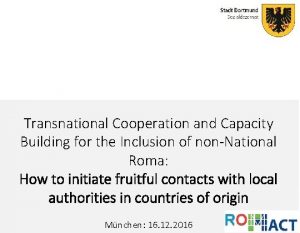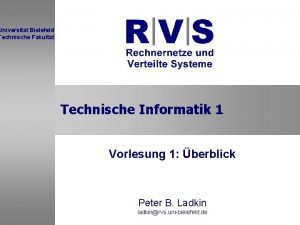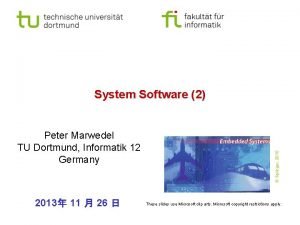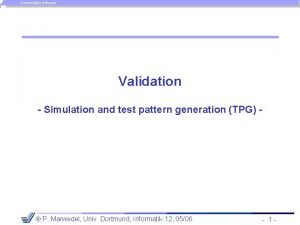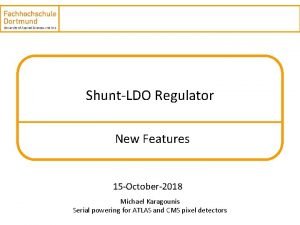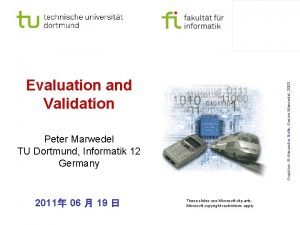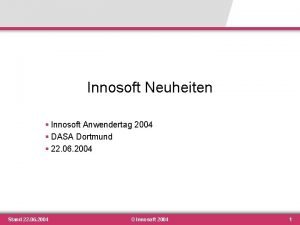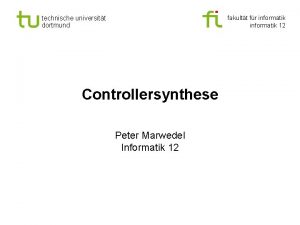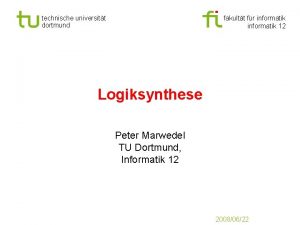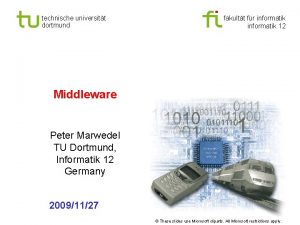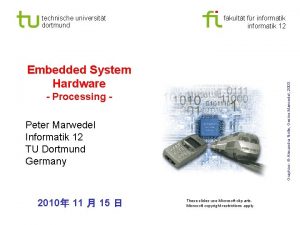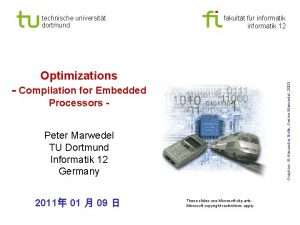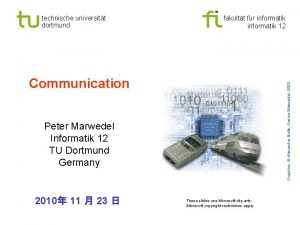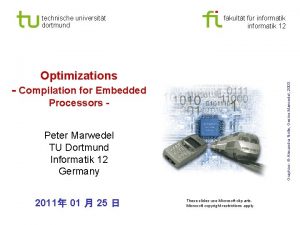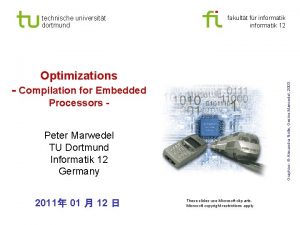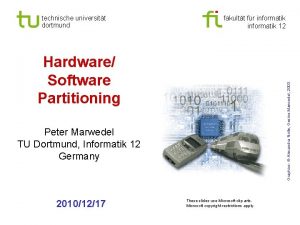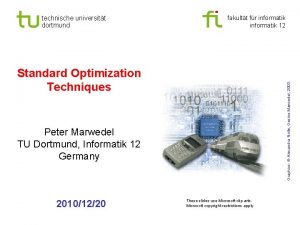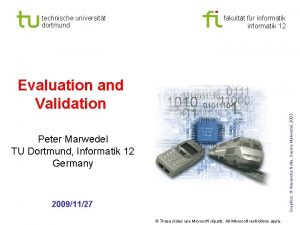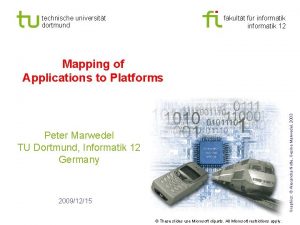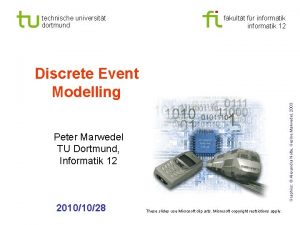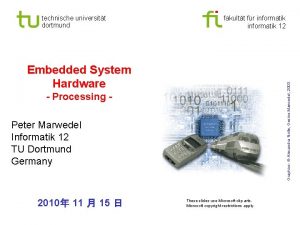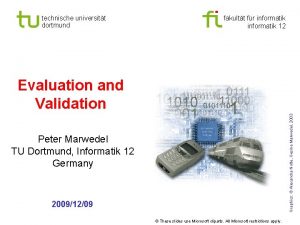technische universitt dortmund fakultt fr informatik 12 Graphics















![Example of a more recent commercial emulator [www. verisity. com/images/products/xtremep{1|3}. gif ] technische universität Example of a more recent commercial emulator [www. verisity. com/images/products/xtremep{1|3}. gif ] technische universität](https://slidetodoc.com/presentation_image_h2/2d245c413bd200ecbac01490c06823b3/image-16.jpg)











- Slides: 27

technische universität dortmund fakultät für informatik 12 Graphics: © Alexandra Nolte, Gesine Marwedel, 2003 Evaluation and Validation Peter Marwedel TU Dortmund, Informatik 12 Germany 2010年 12 月 05 日 These slides use Microsoft clip arts. Microsoft copyright restrictions apply.

Application Knowledge Structure of this course 2: Specification Design repository 3: ES-hardware 6: Application mapping 4: system software (RTOS, middleware, …) Design 8: Test 7: Optimization 5: Evaluation & validation & (energy, cost, performance, …) Numbers denote sequence of chapters technische universität dortmund fakultät für informatik p. marwedel, informatik 12, 2010 - 2 -

Evaluation of designs according to multiple objectives Different design objectives/criteria are relevant: § Average performance § Worst case performance § Energy/power consumption § Thermal behavior § Reliability § Electromagnetic compatibility § Numeric precision § Testability § Cost § Weight, robustness, usability, extendibility, security, safety, environmental friendliness technische universität dortmund fakultät für informatik p. marwedel, informatik 12, 2010 - 3 -

Kopetz‘s 12 design principles (1 -3) 1. Safety considerations may have to be used as the important part of the specification, driving the entire design process. 2. Precise specifications of design hypotheses must be made right at the beginning. These include expected failures and their probability. 3. Fault containment regions (FCRs) must be considered. Faults in one FCR should not affect other FCRs. technische universität dortmund fakultät für informatik Passenger compartment stable Safety-critical & non-safety critical electronics p. marwedel, informatik 12, 2010 - 4 -

Kopetz‘s 12 design principles (4 -6) 4. A consistent notion of time and state must be established. Otherwise, it will be impossible to differentiate between original and followup errors. 5. Well-defined interfaces have to hide the internals of components. 6. It must be ensured that components fail independently. technische universität dortmund fakultät für informatik source p. marwedel, informatik 12, 2010 Follow-up t 2 independent brake hose systems - 5 -

Kopetz‘s 12 design principles (7 -9) 7. Components should consider themselves to be correct unless two or more other components pretend the contrary to be true (principle of self-confidence). 8. Fault tolerance mechanisms must be designed such that they do not create any additional difficulty in explaining the behavior of the system. Fault tolerance mechanisms should be decoupled from the regular function. 9. The system must be designed for diagnosis. For example, it has to be possible to identifying existing (but masked) errors. technische universität dortmund fakultät für informatik p. marwedel, informatik 12, 2010 one of the systems sufficient for braking - 6 -

Kopetz‘s 12 design principles (10) 10. The man-machine interface must be intuitive and forgiving. Safety should be maintained despite mistakes made by humans technische universität dortmund fakultät für informatik p. marwedel, informatik 12, 2010 airbag - 7 -

Kopetz‘s 12 design principles (11 -12) 11. Every anomaly should be recorded. These anomalies may be unobservable at the regular interface level. Recording to involve internal effects, otherwise they may be masked by fault-tolerance mechanisms. 12. Provide a never-give up strategy. ES may have to provide uninterrupted service. Going offline is unacceptable. technische universität dortmund fakultät für informatik p. marwedel, informatik 12, 2010 - 8 -

Evaluation of designs according to multiple objectives Different design objectives/criteria are relevant: § Average performance § Worst case performance § Energy/power consumption § Thermal behavior § Reliability § Electromagnetic compatibility § Numeric precision § Testability § Cost § Weight, robustness, usability, extendibility, security, safety, environmental friendliness technische universität dortmund fakultät für informatik p. marwedel, informatik 12, 2010 - 9 -

Electro-magnetic compatibility (EMC) Example: car engine controller Red: high emission; Validation of EMC properties often done at the end of the design phase. technische universität dortmund fakultät für informatik p. marwedel, informatik 12, 2010 Source: http: //intrage. insa-tlse. fr/ ~etienne/emccourse/what_for. html - 10 -

Simulations § Simulations try to imitate the behavior of the real system on a (typically digital) computer. § Simulation of the functional behavior requires executable models. § Simulations can be performed at various levels. § Some non-functional properties (e. g. temperatures, EMC) can also be simulated. § Simulations can be used to evaluate and to validate a design technische universität dortmund fakultät für informatik p. marwedel, informatik 12, 2010 - 11 -

Validating functional behavior by simulation Various levels of abstractions used for simulations: § High-level of abstraction: fast, but sometimes not accurate § Lower level of abstraction: slow and typically accurate § Choosing a level is always a compromise technische universität dortmund fakultät für informatik p. marwedel, informatik 12, 2010 - 12 -

Simulations Limitations § Typically slower than the actual design. Violations of timing constraints likely if simulator is connected to the actual environment § Simulations in the real environment may be dangerous § There may be huge amounts of data and it may be impossible to simulate enough data in the available time. § Most actual systems are too complex to allow simulating all possible cases (inputs). Simulations can help finding errors in designs, but they cannot guarantee the absence of errors. technische universität dortmund fakultät für informatik p. marwedel, informatik 12, 2010 - 13 -

Rapid prototyping/Emulation § Prototype: Embedded system that can be generated quickly and behaves very similar to the final product. § May be larger, more power consuming and have other properties that can be accepted in the validation phase § Can be built, for example, using FPGAs. Example: Quickturn Cobalt System (1997), ~0. 5 M$ for 500 kgate entry level system Source & ©: http: //www. eedesign. com/editorial/1997/toolsandtech 9703. html technische universität dortmund fakultät für informatik p. marwedel, informatik 12, 2010 - 14 -

Emulation § Simulations: based on models, which are approximations of real systems. § In general: some difference between the real system and the model. § Reduce gap by implementing some parts of our SUD more precisely! Definition: Emulation is the process of executing a model of the SUD where at least one component is not represented by simulation on some kind of host computer. “Bridging the credibility gap is not the only reason for a growing interest in emulation—the above definition of an emulation model remains valid when turned around— an emulation model is one where part of the real system is replaced by a model. Using emulation models to test control systems under realistic conditions, by replacing the “real system“ with a model, is proving to be of considerable interest … [Mc. Gregor, 2002] technische universität dortmund fakultät für informatik p. marwedel, informatik 12, 2010 - 15 -
![Example of a more recent commercial emulator www verisity comimagesproductsxtremep13 gif technische universität Example of a more recent commercial emulator [www. verisity. com/images/products/xtremep{1|3}. gif ] technische universität](https://slidetodoc.com/presentation_image_h2/2d245c413bd200ecbac01490c06823b3/image-16.jpg)
Example of a more recent commercial emulator [www. verisity. com/images/products/xtremep{1|3}. gif ] technische universität dortmund fakultät für informatik p. marwedel, informatik 12, 2010 - 16 -

Formal verification § Formal verification = formally proving a system correct, using the language of mathematics. § Formal model required. Obtaining this cannot be automated. § Model available try to prove properties. § Even a formally verified system can fail (e. g. if assumptions are not met). § Classification by the type of logics. Ideally: Formally verified tools transforming specifications into implementations (“correctness by construction“). In practice: Non-verified tools and manual design steps validation of each and every design required Unfortunately has to be done at intermediate steps and not just for the final design Major effort required. technische universität dortmund fakultät für informatik p. marwedel, informatik 12, 2010 - 17 -

Propositional logic (1) § Consisting of Boolean formulas comprising Boolean variables and connectives such as and . § Gate-level logic networks can be described. § Typical aim: checking if two models are equivalent (called tautology checkers or equivalence checkers). § Since propositional logic is decidable, it is also decidable whether or not the two representations are equivalent. § Tautology checkers can frequently cope with designs which are too large to allow simulation-based exhaustive validation. technische universität dortmund fakultät für informatik p. marwedel, informatik 12, 2010 - 18 -

Propositional logic (2) § Reason for power of tautology checkers: Binary Decision Diagrams (BDDs) § Complexity of equivalence checks of Boolean functions represented with BDDs: O(number of BDD-nodes) (equivalence check for sums of products is NP-hard). #(BDD-nodes) not to be ignored! § Many functions can be efficiently represented with BDDs. In general, however, the #(nodes) of BDDs grows exponentially with the number of variables. § Simulators frequently replaced by equivalence checkers if functions can be efficiently represented with BDDs. § Very much limited ability to verify FSMs. technische universität dortmund fakultät für informatik p. marwedel, informatik 12, 2010 - 19 -

First order logic (FOL) FOL includes quantification, using and . Some automation for verifying FOL models is feasible. However, since FOL is undecidable in general, there may be cases of doubt. technische universität dortmund fakultät für informatik p. marwedel, informatik 12, 2010 - 20 -

Higher order logic (HOL) Higher order logic allows functions to be manipulated like other objects. For higher order logic, proofs can hardly ever be automated and typically must be done manually with some proof-support. technische universität dortmund fakultät für informatik p. marwedel, informatik 12, 2010 - 21 -

Model checking Aims at the verification of finite state systems. Analyzes the state space of the system. Verification using this approach requires three stages: § generation of a model of the system to be verified, § definition of the properties expected, and § model checking (the actual verification step). technische universität dortmund fakultät für informatik p. marwedel, informatik 12, 2010 - 22 -

2 types of input Verification tools can prove or disprove the properties. In the latter case, they can provide a counter-example. Example: Clarke’s EMC-system technische universität dortmund fakultät für informatik p. marwedel, informatik 12, 2010 - 23 -

Examples 1. M, s ⊨ AGg means: in the transition graph M, property g holds for all paths (denoted by A) and all states (denoted by G). 2. For the Thalys example, we could prove that the number of trains is indeed constant. technische universität dortmund fakultät für informatik p. marwedel, informatik 12, 2010 - 24 -

Computational properties § Model checking is easier to automate than FOL. § In 1987, model checking was implemented using BDDs. § It was possible to locate several errors in the specification of the future bus protocol. § Model checking becoming very popular § Extensions are needed in order to also cover real-time behavior and numbers. technische universität dortmund fakultät für informatik p. marwedel, informatik 12, 2010 - 25 -

ACM Turing award 2008 granted for basic work on model checking Edmund M. Clarke, CMU, Pittsburgh E. Allen Emerson, U. Texas at Austin Joseph Sifakis, VERIMAG, Grenoble technische universität dortmund fakultät für informatik p. marwedel, informatik 12, 2010 - 26 -

Summary Evaluation and Validation § Reliability • Kopetz’ 12 principles § Simulation § Emulation § Formal verification • • Propositional, first order, higher order based techniques, model checking technische universität dortmund fakultät für informatik p. marwedel, informatik 12, 2010 - 27 -
 Oth regensburg exchange
Oth regensburg exchange Rechnerstrukturen tu dortmund
Rechnerstrukturen tu dortmund Technische informatik 2 tu bs
Technische informatik 2 tu bs Memory z dortmund
Memory z dortmund Technische graphics
Technische graphics Technische graphics
Technische graphics Ccc freiburg
Ccc freiburg Universitt wien
Universitt wien Universitt
Universitt Harvard universitt
Harvard universitt Computer graphics introduction ppt
Computer graphics introduction ppt Graphics monitors and workstations
Graphics monitors and workstations Valutierend
Valutierend Retina tu dortmund
Retina tu dortmund Funktionale programmierung tu dortmund
Funktionale programmierung tu dortmund Thermico dortmund
Thermico dortmund Unibib tu dortmund
Unibib tu dortmund Zubair khan dortmund
Zubair khan dortmund Rechnerstrukturen tu dortmund
Rechnerstrukturen tu dortmund Dortmund arbeitslosenquote
Dortmund arbeitslosenquote Vorlesung
Vorlesung Lsf fh dortmund
Lsf fh dortmund Srp tu dortmund
Srp tu dortmund Dortmund pattern
Dortmund pattern Karagounis fh dortmund
Karagounis fh dortmund Alexandra nolte
Alexandra nolte Tu dortmund rechnerstrukturen
Tu dortmund rechnerstrukturen Innosoft einsatzplanung
Innosoft einsatzplanung
